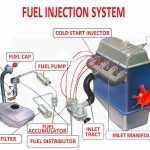In 1914 a young American engineer, William T. Price, began to experiment with an engine that would operate with a lower compression ratio than that of the diesel and at the same time would not require either hot bulbs or tubes. As soon as his experiments began to show promise, he applied for patents.
In Price’s engine the selected compression pressure of nearly 1.4 megapascals (203 pounds per square inch) did not provide a high enough temperature to ignite the fuel charge when starting. Ignition was accomplished by a fine wire coil in the combustion chamber. Nichrome wire was used for this because it could easily be heated to incandescence when an electric current was passed through it. The experimental engine had a single horizontal cylinder with a bore of 43 cm (17 inches) and a stroke (maximum piston movement) of 48 cm (19 inches) and operated at 257 revolutions per minute. Because the nichrome wire required frequent replacement, the compression pressure was raised to 2.4 megapascals (348 pounds per square inch), which did provide a temperature high enough for ignition when starting. Some of the fuel charge was injected before the end of the compression stroke in an effort to increase the cycle timing and to keep the nichrome wire glowing hot.
In the meantime many engines of the two-stroke-cycle, semidiesel type were being installed. Some were used to produce electricity for small municipalities, while others were installed in water-pumping plants. Many provided power for tugs, fishing boats, trawlers, and workboats.
In the early 1920s the General Electric Company suggested to the Ingersoll-Rand Company, for whom Price was working, that they cooperate in the building of a diesel-electric locomotive. At that time many of the locomotives in service were powered by gasoline engines. A diesel-electric locomotive with Price’s engine was completed in 1924 and placed in service for switching purposes in New York City. The success of this locomotive resulted in orders from railroads, factories, and open-pit mines. The engine used in most of these installations was a six-cylinder, 25-cm (10-inch) bore, 30-cm (12-inch) stroke system, rated 300 brake horsepower at 600 revolutions and weighing 6,800 kg (15,000 pounds).
Subsequent developments and applications
Many diesel engines were purchased for marine propulsion. The diesels, however, normally rotated faster than was desirable for the propellers of large ships because the high speeds of the huge propellers tended to create hollowed-out areas within the water around the propeller (cavitation), with resultant loss of thrust. The problem did not exist, however, with smaller propellers, and diesel engines proved especially suitable for yachts, in which speed is desired. The problem was solved by utilizing a diesel-electric installation in which the engines were connected to direct-current generators that furnished the electricity to drive an electric motor connected to the ship’s propeller. There were also many installations in which the diesel was connected either directly or through gears to the propeller. When diesel engines with larger horsepower and slower rotation speeds became available, they were installed in cargo and passenger ships.
The diesel engine became the predominant power plant for military equipment on the ground and at sea during World War II. Since then it has been adopted for use in heavy construction machinery, high-powered farm tractors, and most large trucks and buses. Diesel engines also have been installed in hospitals, telephone exchanges, airports, and various other facilities to provide emergency power during electrical power outages. In addition, they have been used in automobiles, albeit on a limited scale. Although diesels provide better fuel economy than gasoline engines, they do not run as smoothly as the latter and emit higher levels of pollutants.


